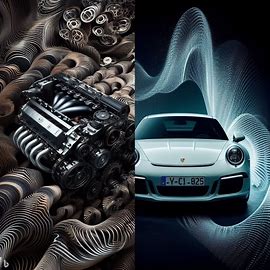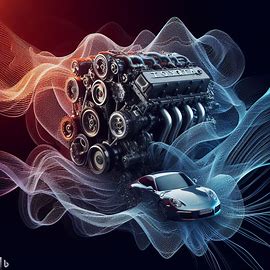Imagine standing at a racetrack, surrounded by the symphony of engine notes. The deep growl of a Chevy Corvette’s V-8 engine, the smooth purr of a Porsche flat-six – these sounds captivate automotive enthusiasts.
But have you ever wondered why these engines produce such distinct notes?
In this article, we delve into the fascinating world of engine acoustics, exploring the physics behind the symphony of power that emanates from our beloved vehicles.
Join us as we uncover the secrets behind the unique sounds of a Toyota V-6 and a Porsche flat-six.

Key Takeaways
- Engine sounds are generated by vibrations that cause air-pressure disturbances, and the frequency of a sound wave determines its pitch.
- The overall timbre of an engine’s sound is determined by numerous variables, including factors like exhaust tuning and design factors such as exhaust layout and insulation.
- Differences in engine sound can be attributed to factors like firing order, engine shape, and manifold layout, as well as additional vibrations in the structure and plumbing.
- Fast Fourier Transform (FFT) plots can be used to analyze and compare the sound characteristics of different engines, helping identify dominant frequencies and compare them between engines.
The Science of Engine Sounds
One of the key factors in determining an engine’s overall sound character is the dominant frequency, which is calculated based on the engine’s rpm. The dominant frequency represents the primary pitch or tone that is produced by the engine.
It is determined by the number of times the engine’s cylinders fire in a given period, known as the firing frequency. For example, a six-cylinder engine has a firing frequency that is the third engine order. This means that the dominant frequency of the engine’s sound will be three times the firing frequency.
The dominant frequency plays a crucial role in defining the sound signature of an engine and can vary significantly between different engine configurations and designs.
Factors Affecting Engine Sound
Design factors, such as exhaust layout, insulation, and the body shell, contribute to the overall timbre of an engine’s sound. These elements play a crucial role in shaping the unique characteristics and tone of an engine’s sound.
The exhaust layout determines the path and flow of exhaust gases, which can affect the intensity and resonance of the sound produced.
Insulation helps to dampen and control vibrations, reducing unwanted noise and enhancing the desired sound profile.
Additionally, the design of the body shell can influence the way sound waves propagate and interact with the surrounding environment, further shaping the engine’s sound.
Differences in Engine Sound
Even if two engines generate the same dominant frequency, they can still sound different due to additional vibrations in the structure and plumbing, as well as variations in the firing order, engine shape, and manifold layout. These factors play a significant role in shaping the unique sound characteristics of different engines.
For example, the Ferrari 458 Italia’s flat-plane crank V-8 produces a silken, sonorous sound, while the Chevy Corvette’s small-block V-8 emits a lumpy burble due to its cross-plane crank and firing order.
The overall sound character of an engine is defined by the pitches that build on the root note to create its distinctive chord. Understanding these differences is crucial for automakers and enthusiasts alike, as it allows for the appreciation of the intricate and captivating symphony created by engines.
The Colors of the Wind
The Fast Fourier Transform (FFT) plots visually depict the frequencies recorded at the tailpipes of the cars, with the color indicating the loudness in decibels and the vertical axis showing the frequencies. These plots provide valuable insights into the sound characteristics of different engines.
By analyzing the FFT plots, engineers can identify the dominant frequencies and compare them between engines. Higher frequencies correspond to higher pitches, allowing for a detailed analysis of the engine’s sound profile.
Additionally, the FFT plots can be used to compare and evaluate the effectiveness of different engine sound enhancement techniques.
Overall, the FFT plots serve as a powerful tool in understanding and studying the complex world of engine sounds, helping automakers create the desired sound profiles for their vehicles.
Engine Sound Enhancement
Automakers often utilize electronic sound enhancement, both through cabin speakers and electromagnetic shakers, in order to alter the perceived engine timbre and generate specific frequencies that mimic the sound of a different engine. By manipulating engine rpm and load, automakers can generate the desired frequencies to mimic the sound of a more powerful or sportier engine.
This artificial enhancement has become popular among automakers due to its cost-effectiveness and minimal weight addition. Additionally, it allows automakers to meet pass-by noise regulations, which set limits on the loudness of vehicles. The test procedure for pass-by noise involves accelerating at full throttle from an initial speed to redline.
Through electronic sound enhancement, automakers can create a unique and distinctive engine sound that enhances the overall driving experience for consumers.
Understanding Dominant Frequencies
I find it fascinating to explore the relationship between engine rpm and the dominant frequencies that contribute to the unique sound of each engine. The sound of an engine is not only determined by its rpm, but also by factors such as the firing order, engine shape, and manifold layout. These factors control the way the bangs mix together, creating a distinct engine sound.
Additionally, design factors like exhaust layout, insulation, and the body shell also play a role in shaping the sound. By analyzing and comparing the frequencies recorded at the tailpipes using techniques like Fast Fourier Transform (FFT) plots, we can identify the dominant frequencies of different engines.
This understanding of dominant frequencies can help in the development of engine sound enhancement techniques, which aim to mimic the sound of different engines using electronic means.
Pass-by Noise Regulations
Pass-by noise regulations aim to set limits on the loudness of vehicles and ensure compliance with established noise standards. These regulations are implemented to address the concerns regarding excessive vehicle noise, which can have negative impacts on public health and the environment.
The test procedure for pass-by noise involves accelerating the vehicle at full throttle from an initial speed to redline. The noise generated during this acceleration is recorded and compared against the prescribed limits.
Conclusion
In conclusion, the distinctive sounds produced by different engines are not merely a result of mechanical operation, but rather a complex interplay of physics. Factors such as vibrations, frequencies, and combustion processes all contribute to the unique timbre of engine notes.
By understanding these principles, we can appreciate why a Toyota V-6 and a Porsche flat-six sound so different from each other.
With advanced techniques such as Fast Fourier Transform plots and sound enhancement, we can further enhance and analyze engine sounds.
For example, imagine a future where electric vehicles are designed to mimic the iconic engine notes of classic cars, providing the same thrilling auditory experience without the use of internal combustion engines.
